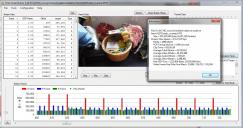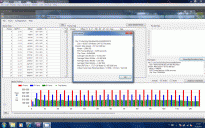
PTool v3.62d topic
-
@vladnik
>GH2 filtering image at 24 qp min before being decoded.
Can you please tell me how you got this number, etc.
In more detail.
-
Yes I have Towi. The difference between replacing T4 with T2 as opposed to T1 is negligble, but my tests weren't exactly great, I just wanted to see if it fixed the cadence problem. I did notice some small pulsing sections with the T2 in streamparser, but it was probably down to what I was actually shooting (and I couldnt see anything noticeable hapening to the footage, but havent analysed it properly). Anyway the still scene I shot for 2 minutes did settle down into a consistent pattern, its just the switch from the first 20 odd seconds to slightly different frame sizes that is still weird. I'd like to spend more time on this but things are pretty hectic here, so I'm doing these tests while doing other things.
Vitaliy, any thoughts on the frame size changes I see after 20 seconds where B frames grow and I and P frames shrink ? I think what I'm asking really is what is the trade off for this solution ?
Edit : If you check the overall bit rates things seem to stay consistent accross the tables used, its just where the bit rate is allocated that seems to alter with each table. But I'm only guessing. -
@Vitaliy_Kiselev
from Cbrandin
quote
I think Panasonic gets around some of the filtering CPU overhead by using pre-calculated tables. Those tables don't change below a QP of about 24. My guess is that they didn't bother with lower settings because they assume the QP will never go below 20 (the factory low limit). I think I know where they are, but the parameter tables have other stuff mixed in. I'll have to decipher what they are doing.
Chris
-
@vitaly
cool, thanks!
so when the "fallback" table (T4) is set for example to T2 ... don't we have to set T3 also to T2?? -
>Vitaliy, any thoughts on the frame size changes I see after 20 seconds where B frames grow and I and P frames shrink ?
I have some ideas.
Try to double "Time Value 1" and "Time Value 2" in testers section and see if this 20 seconds will become 40 seconds, ok? -
@vladnik
I see, we'll talk to Chris about this in upcoming week. -
>don't we have to set T3 also to T2??
No. -
Oh! is it swtiching to different tables while recording the stream, so what I'm seeing after those 20 seconds is a switch to the Table I've selected instead of the T4 table ?
-
thanks!
-
> Try to double "Time Value 1" and "Time Value 2" in testers section and see if this 20 seconds will become 40 seconds, ok?
will do, give us a bit. -
It does move on the change a little bit in the timeline but only by about 4 - 5 seconds. I doubled the Time Values to 36000000 and 18000000. This is still AQ3 and T4 replaced with T1.

 AQ3T1_timevalues_x2.jpg1298 x 684 - 289K
AQ3T1_timevalues_x2.jpg1298 x 684 - 289K -
I noticed strange phenomenon when I tested the new Ptool. I had 14 - 140 lens and i was shooting floating ducks. 1080/50i was 50000000, the GPO 6 and AQ 3. Without Zoom, everything worked OK. Zoom in the middle everything worked OK, Zoom in full kamerara crashed.
-
>Perhaps this is a reason we do not see a drastic difference between 44 and 88 mbit<<br />
No, there never will be a drastic difference 44 and 88 Mbps
the fill with zeros only leads to larger files and not to a better image -
>the fill with zeros only leads to larger files and not to a better image
Sometimes it is better to keep such theories to yourself. -
Prolly you already know about this.
I doubled the default GOP sizes. 24 for 24p, 60 for 60p, 30 for 60i. Every and each mode consistently produced average overall bitrate slightly more than only half the size of specified overall bitrate. -
It does not fill with zeros
Image is degraded at the beginning so higher bitrates cant do much
H264 is made as delivery codec for Blu-ray, internet etc , not production.
AVCHD uses a lot of enhancement to decrease artifacts/blockiness and smooth image,
but price is less details and sharpness plus plastic look of textures.
now we have high bitrate pacth , 130mbit can give us look visually identical to uncompressed 420 if we can feed the codec with clean data . -
@vladnik
I guess I was a little unclear about the filtering. The QP does gown as much as you set it to. It's the deblocking filters that don't seem to change at low (below 24) QP values - they are totally different things. This is somewhat of a theory now - needs more research.
Chris -
@cbrandin
u been very clear .I know that we can set QP, but before decoding frames go through deblocking so first loop filter 24 qp than qp we set .
quote
Furthermore all P- and B-Frames in H.264 streams refer to the deblocked frames instead of the unprocessed ones, which improves the compressibility. -
@Butt
"">Perhaps this is a reason we do not see a drastic difference between 44 and 88 mbit<<br />
No, there never will be a drastic difference 44 and 88 Mbps
the fill with zeros only leads to larger files and not to a better image""
We are in fact seeing a very dramatic difference but only in shadows and with a LOT of motion. The difference is huge though in terms of grading. Not wanting a war here or anything, just want to clarify that we really DO see a difference.
And, btw, we've moved 44 low to 52 now, as that does seem to help quite a bit with the shadows. -
@cosimo_bullo
would love to see 44mbs graded vs 88 or higher,I wont have my editing pc for another week, would be great if you can show as a grading test between the two..thanks -
In my case, 1080p24 T4=1080p24 T1 seems to fix the cadence issue, or at least flatten the ripples greatly.
-
@kron. Yep did the same for me. However, I've gone back to turning AQ off and it's all okay. Obvioulsy, it means dropping detail in shadows etc, but consistency is more important to me now. For example, shooting the death chart for 3 and a half minutes with AQ4 showed no cadence issues (with T4 left as it is, unchecked), but then shoting a normal mostly static indoor scene resulted in the issue appearing again after shooting about 1 minute of footage. Are you sure you're happy with the T1 setting, aren't you getting a drop off in I and P frame sizes after about 20 seconds ?
Even with AQ off I am keeping the frame buffers doubled, as I figure that when I shoot high detail scenes that are going to drive it up to the 44MB, it will still help the codec out a lot with regard the ratios of I to B and P. What I'd like to know is if the cadence issue is bit rate related, as in does it not appear at 66MB GOP 12. Basically, are we the only ones noticing this, or is noone else checking footage shot thats a couple of minutes long ?
Edit : Could the problem be related to lowlight static shots specifically ? As in its messing something up over time in a scene with a lot of shadows ? -
Correct, around the 30s mark the I and P frames get smaller and the B frames bigger. Maybe you're right about it being bitrate related, I don't know. I did not try over 44Mb myself as it seems pointless. If double the stock bitrate isn't enough, something's wrong with the hack, I think.
-
its the camera not the hack. =)!
This topic is closed.
← All Discussions Start New Topic


Howdy, Stranger!
It looks like you're new here. If you want to get involved, click one of these buttons!
Categories
- Topics List23,970
- Blog5,724
- General and News1,346
- Hacks and Patches1,153
- ↳ Top Settings33
- ↳ Beginners255
- ↳ Archives402
- ↳ Hacks News and Development56
- Cameras2,360
- ↳ Panasonic990
- ↳ Canon118
- ↳ Sony155
- ↳ Nikon96
- ↳ Pentax and Samsung70
- ↳ Olympus and Fujifilm100
- ↳ Compacts and Camcorders300
- ↳ Smartphones for video97
- ↳ Pro Video Cameras191
- ↳ BlackMagic and other raw cameras117
- Skill1,961
- ↳ Business and distribution66
- ↳ Preparation, scripts and legal38
- ↳ Art149
- ↳ Import, Convert, Exporting291
- ↳ Editors191
- ↳ Effects and stunts115
- ↳ Color grading197
- ↳ Sound and Music280
- ↳ Lighting96
- ↳ Software and storage tips267
- Gear5,414
- ↳ Filters, Adapters, Matte boxes344
- ↳ Lenses1,579
- ↳ Follow focus and gears93
- ↳ Sound498
- ↳ Lighting gear314
- ↳ Camera movement230
- ↳ Gimbals and copters302
- ↳ Rigs and related stuff272
- ↳ Power solutions83
- ↳ Monitors and viewfinders339
- ↳ Tripods and fluid heads139
- ↳ Storage286
- ↳ Computers and studio gear560
- ↳ VR and 3D248
- Showcase1,859
- Marketplace2,834
- Offtopic1,319











